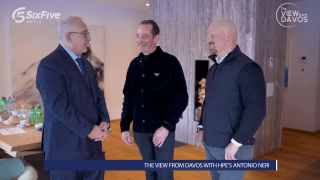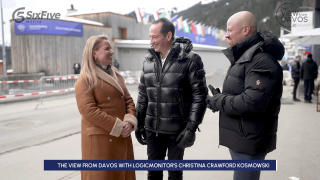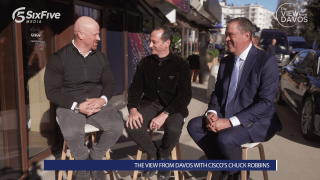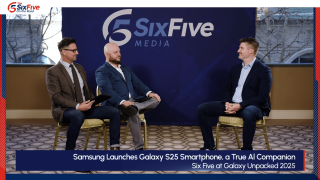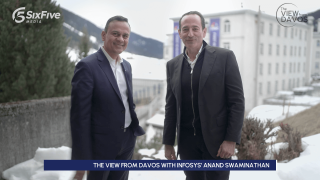What’s Qualcomm’s CEO Cristiano Amon saying from Davos?
He has great optimism for growth and the crucial role of collaboration between public-private partnerships in driving progress. Find out why below ⬇
Hosts Daniel Newman and Patrick Moorhead are back with another interview on The View From Davos. They met up with Qualcomm‘s Cristiano Amon, President and Chief Executive Officer, to discuss the latest tech advancements and market trends observed at this year’s WEF. Cristiano shares his valuable insights from the forum including his optimism for growth and the crucial role of collaboration between public-private partnerships in driving progress.
Check out the full interview for more on:
- AI in real-world applications and tangible value creation with are top of mind for business and government leaders
- Edge computing is key to unlocking AI’s potential: Latency, privacy, and cost are driving a shift towards distributed computing power
- The lines between cloud and edge are blurring
- Qualcomm’s role in powering AI innovation across industries, from mobile to automotive to industrial IoT
- A new era of IoT is dawning: Advances in AI, edge computing, and connectivity are creating opportunities for a resurgence of the Internet of Things.
Learn more at Qualcomm.
Watch the video below, and be sure to subscribe to our YouTube channel, so you never miss an episode.
Or listen to the audio here:
Disclaimer: The View From Davos is for information and entertainment purposes only. Over the course of this webcast, we may talk about companies that are publicly traded and we may even reference that fact and their equity share price, but please do not take anything that we say as a recommendation about what you should do with your investment dollars. We are not investment advisors, and we ask that you do not treat us as such.
Transcript:
Patrick Moorhead: The Six Five is On the Road with a View from Davos. We’re here at World Economic Forum, having many awesome conversations. World Economic Forum is truly unique, it’s really the intersection of government, commerce and finance, and a lot of technology. And the conversations have been really insightful, haven’t they, Dan?
Daniel Newman: Yeah, Pat. This is the year that all the buildup that’s happened about AI and infrastructure and investment’s starting to come to fruition. The conversations I’m having have been really focused on how are we going to start to derive value from all these investments? How do we start to see this AI meaningfully impact the world in ways that can be counted, right?
Patrick Moorhead: Right.
Daniel Newman: That’s the World Economic Forum. The numbers lead the discussions here, but the underpinnings, it’s so much technology. And if you just walk up and down the promenade, you see how much technology and how much AI is going to shape the next few years.
Patrick Moorhead: Yeah, and obviously a major player in technology is Qualcomm, and we have CEO Cristiano Amon on the show. Welcome back.
Cristiano Amon: Very good, very happy to be here, it’s my favorite thing to do.
Patrick Moorhead: Yeah, I appreciate that. Thank you.
Daniel Newman: All right, and the beard.
Patrick Moorhead: You probably say that and be all the folks.
Daniel Newman: And the beard.
Patrick Moorhead: Yeah.
Daniel Newman: We’re going to have to ask him about that.
Patrick Moorhead: Exactly. No, but Cristiano, maybe we can start with… We’re obviously here at World Economic Forum, you’ve been a multi-year attendee. What do you like to accomplish here, and what kind of conversations are you having?
Cristiano Amon: Look, it has been very productive, and I think if you look at our presence is increasing, the conversations are becoming larger in terms of the number of companies. And I think it has 100% to do with the Qualcomm diversification and growth efforts, especially as you go to a number of different industries. I think if you look at some of the key meetings. I know there’s a lot going on with mobile, with AI, but there’s a lot of conversations about what we’re doing in automotive, and conversation about what we’re doing in PC. You saw a lot of the PC guys in here as well. You see many companies. There are system integrators for enterprises incredibly interested in AI PCs, and the ability to run models on the PCs and how that’s going to change economics. And then most important, we have been very clear about the role of Qualcomm and industrial and AI at the edge. This is a place that you have every single industry and we have been having conversations about how our technology at the edge can be transformative. And it has been a helpful event to continue to help Qualcomm in our growth and diversification as we take our technology to different industries.
Patrick Moorhead: A great answer.
Daniel Newman: Yeah, no, it was well-thought-out. Qualcomm though is historic around these parts for your nightcap events. Although now you’ve done two this year, because you did the red party which was really great. And then last night you had your big nightcap. And I’ve got some harder questions for you. But before I do, I was so impressed with the mix. We talk about public-private and you brought some just wonderful speakers on stage, really hearing how they’re thinking. And as I said, thinking how they’re leading of course with economic growth. But so much of what sits under the things that companies like Qualcomm are doing. Tell us about the event a little bit, and how this really brings that public-private partnership together.
Cristiano Amon: Yes, so the event is a cool thing. Actually, we started a few years ago, and it’s late. It was 10 PM, was Qualcomm nightcap. It’s becoming a tradition, there’s so many people. They’re coming in, it was good. I think you guys saw it, it’s well attended. You have, as you said, the right mix of CEOs in the government. I will say that with all humility, its company built itself on partnerships. Even when we started our licensing business, we develop a technology and license to everybody so everybody can build it. And I think it speaks to the role of Qualcomm in being a partner of both governments and companies, and I think that’s what you see in the nightcap. And we had, for example, the prime minister of Belgium. We have the finance minister of Germany, we have the AI Minister of France. It was good, having conversation as you saw about the importance of Europe, to understand the need for innovation and how they’re going to reshape their policies to enable innovation to happen, the excitement about AI for all industries, and it was a good discussion. I’m also really excited about having some of the major car company CEOs in here, the PC company CEOs in a number of other industries. And hopefully we’ll continue and be a tradition, and you guys will come in every year.
Daniel Newman: Of course.
Patrick Moorhead: We’d love to do that. Thank you for the invite for the next 10 years, I appreciate that.
Cristiano Amon: Oh, you have it, you have it.
Patrick Moorhead: So Cristiano, Qualcomm, it’s about compute and connectivity, and I think last night was a great example of connectedness in pulling that together. I did want to ask you about the general discussion. There’s so many changes right now, and I obviously have my opinions on what I’ve heard. But what’s your sense about the level of optimism for growth in the industry, the idea of regulation, maybe interactions between different geopolitical nations out here?
Cristiano Amon: Okay. Complicated question, I will do-
Daniel Newman: How much time do we have?
Cristiano Amon: Yeah, yeah, yeah.
Patrick Moorhead: A 10-part answer here.
Cristiano Amon: But I’ll do my best to give a simple answer. Look, there is optimism right now in the industry, and especially… By the way, just frankly speaking, there’s often-
Patrick Moorhead: Well, I heard it last night.
Cristiano Amon: Yes.
Patrick Moorhead: From people I wouldn’t normally expect, I heard optimism.
Cristiano Amon: That’s great. And I think there’s optimism, for example about the US economy. I think there’s expectation, there’s going to be growth. The combination of energy deregulation and technology innovation usually is a good combination. It drove a lot of the thought process about things that need to happen in Europe. And we see companies really thinking maybe this is the year that technology started to move into commercialization. Maybe there’s real value to be created. We obviously have a bias, because we think that the ability to do AI at the edge is going to be transformative. You can leverage all this computing that is going to be out there. Companies are really thinking about how technology is going to transform their company. I can speak all day about automotive companies thinking in a time of a crisis and accelerated competition, we need to innovate, we need to invest in technology, we need to become tech companies, and I think that dialogue is actually positive. So I think there is an expectation that we’re going to start to see some growth. I’ve been cautiously optimistic, but it was good. And if anything, I think there was a wake-up call I think in Europe, we’re here in Europe about needing to accelerate the ability to innovate, and maybe its regulation needs to be targeted towards that, towards innovation. And you heard that from the prime minister.
Patrick Moorhead: 100%.
Cristiano Amon: You’ve heard that, yeah.
Daniel Newman: It was good to hear it, and I had a good laugh. I’ve been telling this story of this funny post I saw online, Cristiano, which showed a US innovation and it shows Musk SpaceX catching the rocket out of midair. And it shows Europe innovation. It shows a guy lowering a bottle cap onto a water bottle with a little string connected to it, and he lets it go and they show the right and the left. So there’s obviously a need, and I think the US drives and I think Europe is seeing how fast we’re moving and hopefully they want to follow. And I know there’s a lot of great partnerships. And by the way, there’s a lot of good purpose in some of what they want to do with data and privacy. It’s not one is right and one is wrong, but we see in the US how fast things go. And now we’ve got even more deregulation.
I want to talk a little bit about Qualcomm specific and the edge. The edge and the AI opportunity. I see so much value from this side of vendors, from the side of states’ governments as it relates to everything from lowering the cost of energy, optimizing energy, bringing compute closer in automotive makes a ton of sense because it’s safe. You don’t want cars making decisions in the cloud. At the same time with things like LLMs though, we’ve seen consumers don’t necessarily care where it’s processed as long as the latency is low enough. How do you see that bifurcation of what gets driven to the edge, and making sure that consumers find value in edge applications that maybe they don’t directly feel, things like lowering costs of energy?
Cristiano Amon: No, look, you touch on a number of very important points.
Daniel Newman: Yeah, that was a long question, yeah.
Cristiano Amon: No, but you have all of the key aspects of it. I want to start by saying this. It’s a mistake to think about, oh, this is going to be cloud or edge, and one versus the other. I’ll give an example. Smartphones are the most cloud-connected devices of any devices. It’s 100% connected. If it’s not connected, it is like an iPod touch. So it is the most cloud-connected device. And at the end of the day, computing power on phones, generation after generation is going to continue to increase because the things that you do on your phone. And I think it’s not going to be different of any computing systems. And I think what’s happening right now is there are reasons that you’re starting to see some of those technologies becoming very relevant. Latency, you talk about that. And it’s funny, because I come, as you guys know, from the wireless industry. You used to talk on the phone. We used to talk on the phone. When we talk on the phone in the past, let’s go talk about the 3G era. Operators, they had an excellent network. There was a premium price for the operator, because voice is unforgiving. We start texting each other. If you have an operator not so good, you move around to still get your text, you equalize it.
But now if you are starting using voice, for example on the phone, to talk with AI, you want a response right away, latency becomes important. Voice becomes important again, so you start to see those technologies, you want a response. A lot of companies, when they start about agents in voice recognition, they say all of the LLM, they do audio to text, needs to be local on the device. Privacy. And the other thing which is interesting, is you mentioned cost. And the cost, you look… We’re starting to go from training to inference, and starting to go to real production and it’s starting to get to the end goal, real commercial value. So companies are coming to say every time somebody pressed the AI button in their application, whether it’s the phone and the PC, I run the stuff on the cloud, it costs me money. And why don’t I use the existing computer that’s available? So we had a number of conversations of ISVs that said, “AI PCs are open platform. I’m just going to push my model down, and I’m going to work on that and that’s free, because the computing is available.” So all of those things are starting to happen, and that’s a great opportunity for us.
Patrick Moorhead: As we bring this conversation to a close, I did want to ask you about priorities for 2025. Your diversification plan is working. Just looking at the numbers, you’d have to be under a rock to not see that, and you’ve extended this even farther to the industrial edge. There seems to be a lot of work, and impetus and effort going into that. What do you want to accomplish? When we’re back here in 2026, the day after your late night party, what do you want to have accomplished?
Cristiano Amon: Look, I’m going to answer this question this way. Because see, one thing about our company, we have to constantly be pushing. So it’s not because we succeeded in one area that we’re going to stop pushing in this area. So I’m going to divide the answer into two folds. Priorities right now is on mobile. We’re very, very aggressive. Now that we have the leadership position and performance, we’re going to drive a transition to AI phones. That’s going to create a lot of opportunities. On cars, our position is accelerating. And now there’s this view that GenAI in the car will create more value on those digital cockpit platforms. In this year of ’25, we’re going to launch our stack. They want to be jointly developing with BMW, so that’s a big priority for us. PC, we’re ramping. Our priority is we’re launching more markets, we’re more activity in the channel. We’re starting to see the designs. We talk about our designs went from 60 to 100.
So those things we’ll continue doing. But there is a new priority that we hopefully when we come here in ’26, we’re going to see traction. We’re super focused on industrial. We had made some acquisitions, we build a new product. We are announcing, we built a new software platform with a different solution for each vertical. Because we believe that there’s going to be incredible value of what I call the next wave of industrial high-performance computing, AI at the edge and connectivity. We build a platform for energy, for retail, for manufacturing, for warehousing. We’re building solutions across those, and hopefully we’ll get some scale when we think about this next year.
Patrick Moorhead: Excellent.
Cristiano Amon: Yeah, we have some other things we’re working on, but I can’t say it right now.
Patrick Moorhead: Ooh, do we hear that everybody?
Daniel Newman: I wish one of these days we could share some of the great conversations we have when we’re not on the record, but unfortunately we just can’t do that. I did want to say, and then I’ll run us out. But it sounds to me from conversations I’ve had, Cristiano, that we are ready for the next era of IoT. Literally, it had that dip. But it seems like with AI, with Edge, with all the compute processing we have now, networking that we’ve created, what we thought could have been IoT five, 10 years ago has a chance to come back really, really strong.
Patrick Moorhead: Yeah, for sure.
Cristiano Amon: 100%. Let me give you a parallel. Sorry, you want to finish your question?
Daniel Newman: No, no, go ahead. Let’s do it.
Cristiano Amon: I’ll give you a parallel.
Daniel Newman: I know we got to go. But cut it in, give the chance to say this part and then we’ll-
Cristiano Amon: No, because I want to give it a parallel. It’s actually very important. When you think about automotive before, what was the automotive platform before? It was microcontrollers not connected. All of a sudden, the car became advanced computing platform. This is now happening with all of the other things in the industry. Microcontrollers get replaced for high-performance computing with AI and connectivity. It’s the same exact transition.
Patrick Moorhead: Excellent.
Daniel Newman: Well, it’s very exciting. Everyone out there, thank you so much for joining The Six Five On the Road with a View from Davos. A great conversation as always with our friend Cristiano Amon, CEO of Qualcomm. Subscribe, be part of our community. Check out all the coverage we had here at this year’s World Economic Forum. Great year ahead, we’ll see you all soon.


